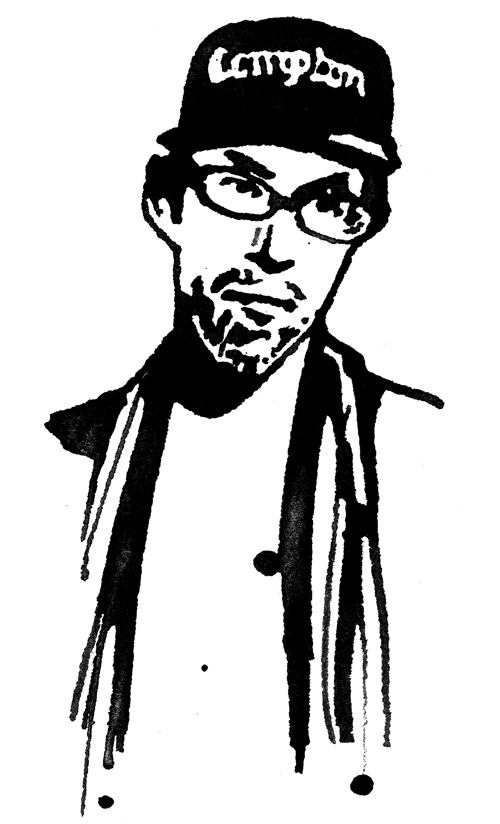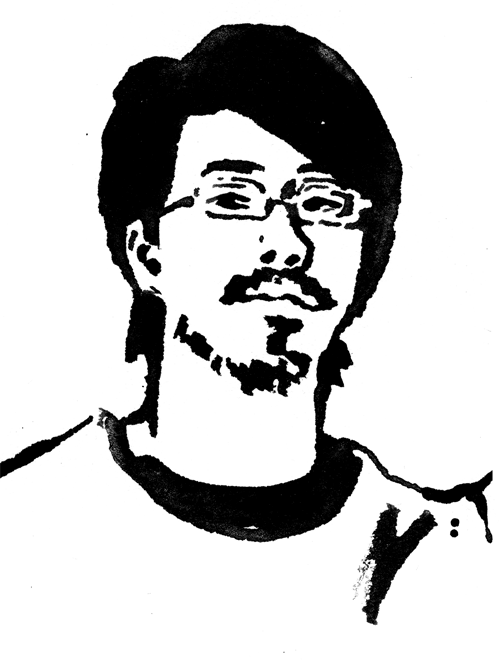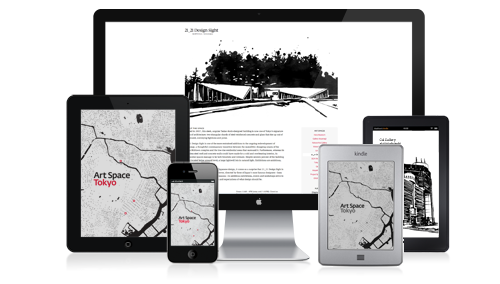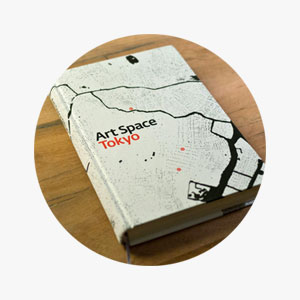Tokyo’s First Satellite Art Fair
An interview with Agatha Wara, Antonin Gaultier, Julia Barnes & Kosuke Fujitaka
101Tokyo Contemporary Art Fair

AGATHA WARA, director
Born in La Paz, Bolivia, she was based in Tokyo from 2004 to 2008, working as an independent curator and writer. After living in Miami, where she co-directed the nonprofit alternative space Bas Fisher Invitational, in 2012 she received her MA from the Center for Curatorial Studies, Bard College, in New York. Currently she is the Curatorial Assistant for the Bergen Assembly in Bergen, Norway.
ANTONIN GAULTIER, producer
Born in Paris, he moved to Tokyo in 2005. He is a musician (aka Digiki), occasional curator, and publisher of De Rigueur, a digital publication on art and fashion.


JULIA BARNES, development and vip relations
he owner / co-director of Nakaochiai Gallery and Nonaca Co., Ltd. Nonaca produced 101Tokyo Contemporary Art Fair in 2008. She now lives in New Zealand.
KOSUKE FUJITAKA, director of operations
One of the co-founders of Tokyo Art Beat and New York Art Beat, he manages 101Tokyo’s public relations and marketing. Since 2008 he has been living in New York.

Why did you feel that now is the time to set up a new art fair in Tokyo?
JBThe idea of making a new fair came up shortly after attending Art Fair Tokyo 2007. Art Fair Tokyo is set up to show antique and modern art as well as contemporary art and I felt that it wasn’t presenting Japan’s contemporary art scene in the best light. We’re all working here in Tokyo to nurture the art scene, the artists, increase the number of local patrons and generally increase the substance of what is being produced, and if our only place to show is Art Fair Tokyo, it won’t make Tokyo a destination for contemporary art. We’re not trying to replace it, but it’s necessary that Tokyo has an all-contemporary art fair showing fresh, exciting and challenging works. Otherwise why bother?
AWThere are a lot of cool, new, internationally oriented contemporary art galleries popping up here in Tokyo. They are taking part in fairs all around the world but they don’t have the chance to participate in an art fair in Tokyo. The contemporary art scene here has been getting more and more vibrant over the past few years, and there are people around the world who want to take part in what’s going on in Tokyo, so the timing is just right. Visiting all the other art fairs around the world, it just made sense. Why not? Why isn’t there something like this already going on in Tokyo?
Is the Japanese art market ready for a second major fair?
JBYes! No! Yes, initially we received criticism from art figures in Japan and abroad. We were told frankly that the art market is not big enough for two fairs to exist in Tokyo. We know that in announcing to the world that Tokyo has an international contemporary art fair, we have to make sure it’s good. I initiated the idea of making a fully contemporary fair and through a conversation with Agatha, 101Tokyo was born. We’re aiming at newcomers to the scene: we want people to get interested in art for the first time and we want to cultivate a new generation of young buyers. Our lecture series at Bloomberg prior to the opening is an insiders’ guide to the art market, on how to go about collecting art and so on.
KFIt’s really easy for people to say that Tokyo is not ready, but you can look at it the other way around: by adding a second major art fair you are pushing the Tokyo art world and making the assertion that yes, Tokyo is ready. Also, if you look at the prices of Japanese contemporary art, it is significantly cheaper than Chinese or Korean art, so this is the chance to make the Japanese contemporary market bigger. It’s really important for 101Tokyo and Art Fair Tokyo, as well as any other art movements here, to inject the art market with some vigor. There are so many people who could be spending money here but aren’t.
Other than focusing exclusively on contemporary art, what are the main ways in which this fair will differ from Art Fair Tokyo?
AGUltimately, art fairs are nothing new. They have existed in Europe and America for a long time as a way for galleries to connect with people interested in investing in art. This approach of prioritizing collectors over art lovers and the general public has worked well but has resulted in galleries seeking the highest return on investment, pushing only the established artists they know they can sell. To me, this is ‘art fair 1.0,’ safe and established in a nice space, and Art Fair Tokyo is an example of that type of fair. That doesn’t mean it can’t be successful, but it will have to reinvent itself — as all ‘old’ fairs do at some point — or else people will start to find it boring. 101Tokyo is a ‘version 2.0,’ and this city has just the right kind of creative environment to make such a fair successful. People working here are very open to the potential for crossovers in art, design, magazines, fashion or music; there are great local galleries and artists.
AWWe’ve been particularly inspired by the model of other fairs like NADA and LISTE, where there is a real feeling of excitement surrounding the fair. We want to pump up the volume on the way art business is currently done in Japan, create a strong program of events in addition to the fair, involve more artists, projects, panel discussions and social events to generate some excitement. Tokyo already has Tokyo Design Week; we want to make Tokyo’s first Art Week in April, so people can come here expecting great art and an opportunity to connect with other people in a stimulating environment.
What can 101 Tokyo do to make the experience of viewing art in such a commercial context more inspiring?
JBhe fair takes place in an abandoned junior high school building in Akihabara, so already the space has atmosphere. We have invited a young and energetic architecture firm called Point to design the space and several artist groups and individuals to do artist projects on the building façade and in other spaces throughout the school. The entire building will be an inspiration.
KFhe main difference is that there will be no aisles. We are having architects design the booths so that they won’t be typical white cubes. The booths will all be interconnected like a maze, so that viewers and gallery owners have to wander through the spaces, rather than just past them.
AWWe’ve kept this in mind throughout the planning of the fair. We understand that a fair is very commercial by nature but we are also interested in upholding quality and keeping in mind that a large part of our audience will be the general public. A panel carefully selected the galleries, based on their applications. So each of the booths will be showing mini-curated exhibitions for all audiences to enjoy. With this innovative architectural design, the whole space will really be an experience to step into.
At the practical level, what have the main challenges been in setting up this fair?
JBIn the early stages, Agatha and Antonin and team spent six weeks on the phone every night from 10pm to 5am, calling up hundreds of galleries all over the world. Typically galleries receive invitations to art fairs in the post or by email, but we wanted to introduce this fair to the international art world with a more personal touch.
Were the galleries receptive to that kind of approach?
AWIt was totally like telemarketing. We had our pitch and we got pretty good at keeping galleries on the phone, no matter how much some of them wanted to hang up on us. A lot of galleries wanted to come but they couldn’t because of scheduling difficulties. I recently read that there are four hundred art fairs worldwide, so frequently they already had something else scheduled. But in general people were receptive; I only remember two international galleries that just yelled, “We’re not interested!” and hung up. The Japanese side was a bit harder though.
Why is that?
AWI think that the Japanese galleries really know their scene, so their familiarity with the status quo makes them doubtful when something new comes along. There were a couple of galleries that were very interested from the very beginning, like Megumi Ogita Gallery and Magical Artroom. Tomio Koyama has been particularly supportive and wanted to be involved from the word go and has been one of our Principal Advisors. He understands the need for this fair and has been very proactive in trying to convince galleries sitting on the fence that they should take part. wanted to know who else would be taking part before committing. So Tomio Koyama did a lot to help break that deadlock. We had to put a personal face on our interactions with the Japanese galleries, visit them a lot and talk with them in detail about the project.
KFAt first, a lot of galleries weren’t sure about us. We started organizing in August 2007, which gave us a very tight schedule. That, plus the fact that they had never heard of us made them doubtful about whether this fair could really happen. And of course they all wanted to know who else would be taking part before committing. So Tomio Koyama did a lot to help break that deadlock. We had to put a personal face on our interactions with the Japanese galleries, visit them a lot and talk with them in detail about the project.
What are your criteria in deciding which of the applicant galleries can take part in the show?
AWEdge! They have to be handling edgy and fresh work. We went back and forth about whether the fair should be about ‘young’ galleries and ‘young’ artists, but we decided that we don’t need to create a niche for ourselves. We’re the only truly international art fair in Tokyo, so we can take the best of what’s on offer regardless of age. It doesn’t matter if the galleries are well established or not as long as they’re showing exciting work.
KFWe also set the condition that they have to exhibit new works at the fair, which is an important selling point. We don’t want a fair full of inventory works!
With June dominated by Art Basel, October by Frieze in London and December by Art Basel Miami Beach, are you confident that you can claim April for Tokyo?
KFWhen I visited ShContemporary, I felt that Tokyo’s infrastructure makes it a lot easier for foreigners who want to take part in the art scene here. Tokyo is very worry-free on many levels in comparison with China, and Tokyo has become a lot cheaper than it was before; if you can cope with London’s prices you can easily cope with Tokyo. There’s a lot of latent potential here, but there isn’t much in the way of a local event that everyone in the Tokyo art world can focus on, so setting up an art week in April is a good opportunity for that.
AWThere are a number of events happening at the same time as Art Fair Tokyo and 101Tokyo, collectively referred to as Marunouchi Art Weeks. Art Award Tokyo is taking place in the Marunouchi Building, the ‘New Tokyo Contemporaries’ association of young galleries will be doing a collaborative show there too. Shinwa Art Auction has also scheduled an auction for the same week. We hope that this combination of events will create a sense of momentum and make people realize that if they want to do something related to contemporary art in Tokyo, then this is the week they should do it in. Of course, we can’t compare these events to the scale of what takes place at Frieze or Art Basel Miami Beach, but we feel a change happening in the contemporary art scene and people taking the initiative to start it.
What have you seen at other art fairs that you either do or don’t want to emulate?
KFAt ShContemporary, the participating Japanese galleries all said that they were selling to Koreans and Taiwanese but not mainland Chinese clients. There’s this lingering concern that perhaps Chinese people don’t like Japanese art, but it’s probably just that there is little to connect Chinese collectors with Japanese galleries. The connections between the Japanese, Korean and Taiwanese contemporary art markets are a little more established and well developed, but there is not so much awareness of Japanese contemporary art in China, so ShContemporary was the first real opportunity for Japanese galleries to make themselves known there. We don’t have any Chinese galleries taking part in 101Tokyo, but in the long term we will aim to build up ties within the Asian contemporary art world. Asian art fairs are the best opportunity for Asian galleries and collectors to get to know each other and start a dialogue.
AWI’m focusing on the things I see at other fairs that work well and inspire me. I’d like to avoid this feeling of ‘too much-ness’ at fairs, too much visual stimulation not giving you time to really look at anything. I’ve been to some fairs where the atmosphere is all too serious, and people are whispering. I’d definitely rather stay away from that kind of environment.
AGI think we face a number of challenges for the years to come. Firstly, we need to work on getting more people to buy art. Deals between art fairs and banks are a good start in facilitating that process, but it may take time to win Japanese banks over. Secondly, simply being a version 2.0 art fair is not enough. What should a version 2.5 art fair be like? How can we better ourselves and differentiate ourselves, not only from Art Fair Tokyo, but from Frieze or NADA? Thirdly, as Kosuke explained, we need to build a new ground for collaboration between Japan, China and the rest of Asia.
Finally there is the more historical and philosophical question of whether ‘contemporary’ makes sense any more. I believe it is starting to sound as tired as the word ‘modern’ and is even becoming quite irrelevant. So how can an art fair truly represent a survey of the art of ‘now’? I think there is a role for art fairs to occupy a position between those of art biennales, museums, galleries, magazines and so on ... we just have to keep the question open.
UPDATE
Although 101Tokyo 2008 was broadly considered successful, creative differences among the fair’s co-founders led to the 2009 edition being organized by a different team. Due to the unavailability of the former Rensei Junior High School (where 101Tokyo 2008 was held) the 2009 edition was put together at the last minute while the organizers looked for a new venue. Eventually it was staged at the nearby commercial event space Akiba Square and was pitched as a more conventional art fair. However, 101Tokyo's momentum was further slowed in 2009 when Art Fair Tokyo established a new annex dedicated to young contemporary galleries. The organizational delays with 101Tokyo 2009 led some of the galleries that had participated in the previous edition to take part in Art Fair Tokyo instead. In 2010, a lack of financial backers meant that no third edition of 101Tokyo was held.

